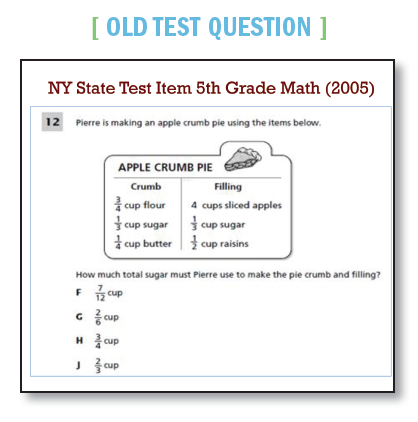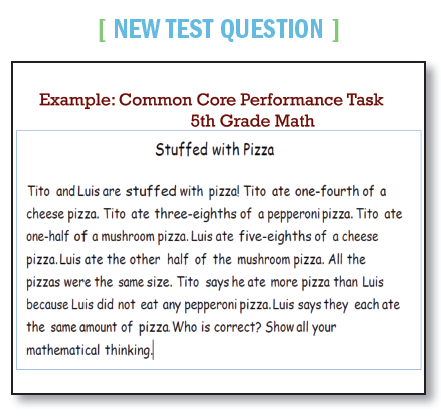While many educators have not had the time nor the tools to delve into the state's new Common Core Learning Standards - let alone expose their students to the curriculum - the reality is this spring's grades 3-8 ELA and math state assessments will be based on the Common Core standards.
It's yet another case of the State Education Department putting the cart before the horse - or in this case, rolling out new tests before aligned curriculum or proper instruction are in place.
While NYSUT supports the shift to Common Core instruction, NYSUT Vice President Maria Neira said it simply isn't fair to move so swiftly to test students on Common Core. "It's becoming clear that the scores of these new assessments should not be used for high-stakes decisions about students," Neira said.
"These tests should not be considered a definitive summation of a student's ability or, for that matter, a teacher's effectiveness. Instead, they should be used as a benchmark for gauging progress in implementing the Common Core."
Neira has voiced these concerns with SED policymakers and shared NYSUT's recent poll of members that shows a wide disparity in implementation, depending on district, content area and grade level. Common Core Learning Standards have been adopted by 46 states, including New York. The state's Common Core Learning Standards call for a variety of "instructional shifts," such as using more nonfiction text in lessons, requiring evidencebased arguments and applying math concepts to real-life problems. Those higher-level thinking skills now will be front and center in this spring's grades 3-8 ELA and math assessments.
Education officials have said the new tests will include more challenging reading passages, three- or four-step math problems and more difficult open-ended questions. A NYSUT Polling Center survey of more than 1,600 teachers in November, supported by a similar survey conducted by the United Federation of Teachers in New York City, shows too many students may not be ready for the new tests. Two-thirds of educators said the state was moving too fast. Many reported a disturbing lack of professional development, instructional guidance, appropriate materials or time to implement instructional changes.
Only one-third said their students have access to textbooks aligned to the Common Core. This varies by subgroup, with half the elementary school teachers saying students have them compared to just 26 percent of math teachers.
Neira said NYSUT's survey shows a clear need for more professional development and an adjusted timeline for implementing the Common Core.
About 38 percent of participants said their district has provided professional development to a "low degree" or "not at all." Only 30 percent reported having additional planning time dedicated to understanding the new standards.
Educators said they were left to get most of their information informally from colleagues. Nearly onethird cited conversations and work with colleagues as the most helpful source, while 27 percent cited district- provided professional development. Half of the respondents said they found SED's EngageNY website a helpful resource.
The survey also found communication with parents is greatly needed. Only 16 percent of educators said they believe parents know the extent to which this spring's state assessments will be based on the Common Core.
Recently released sample test items show the higher level of thinking skills that will be required of students. (See math examples below.)


NYSUT is partnering with the New York State PTA to create a guide to help educate parents on Common Core Learning Standards.
"We can't let this uneven transition unfairly set students and their teachers up for failure," Neira said. "Now's the time for SED to adhere to its own motto: 'as fast as we can, as slow as we must.'"
While SED Commissioner John King has said he expects test scores will go down this year, Neira said SED has a responsibility to better inform the public and parents about the upcoming tests.
"The piecemeal approach and wide disparity among districts will undoubtedly skew results for this first administration," Neira said. "We'll continue to urge SED to do the right thing at this critical time to ensure students are not adversely affected."
KEY COMMON CORE TEST CHANGES
ELA tests
- Speaking and listening will no longer be assessed;
- All text passages will be authentic;
- Some text passages may express opinions with which the reader may disagree;
- Text passages may be longer and more rigorous than on past tests;
- Text will be more complex, more informational;
- ELA tests will be split into four books administered across three days; and
- Grades 3 and 4 will have a shorter maximum testing time.
Math tests
- Focus emphasis on mathematics content and standards. (Not all standards are recommended to receive the same amount of instructional time);
- Questions may assess multiple standards simultaneously;
- Grades 3 and 4 tests will have a shorter maximum testing time;
- Revised SED guidance on math tools, reference sheets; and
- Students in grades 6-8 will not be using calculators with book 1; calculators will be required on books 2 and 3.
WHAT'S AHEAD FOR STATE TESTS
- 2012-13: Grades 3-8 ELA and math tests aligned to Common Core Learning Standards
- 2013-14: Regents in ELA, Algebra 1, Geometry and NYS Alternate Assessments in ELA/ math are aligned
- 2014-15: Algebra II Regents aligned
- 2015-16: Transition to Partnership for Assessment of Readiness for College and Careers (PARCC) computerbased tests for ELA and math grades 3-11, pending Regents approval
Source: SED